- Combining big data in marketing with AI marketing automation enables real-time personalization, predictive insights, and measurable ROI growth.
- An AI fractional CMO aligns strategy, technology, and creative execution to deliver enterprise-level leadership without full-time executive costs.
- Effective AI marketing plans require robust data pipelines, governance, cross-functional collaboration, and compliance with privacy regulations like GDPR and CCPA.
The fusion of artificial intelligence and big data is reshaping modern marketing. Organizations are no longer competing on creative messaging alone; they now compete on the quality of their data pipelines, the sophistication of their algorithms, and the precision of their execution. An effective AI-driven marketing strategy aligns these elements with measurable business outcomes enabling teams to respond faster to customer signals, deliver personalized experiences at scale, and optimize budgets in real time.
This shift is reflected in spending trends: According to Gartner, 63% of marketing leaders have increased investments in AI tools to personalize customer experiences and optimize campaigns. MarketsandMarkets projects the AI for Sales and Marketing market to grow from USD 57.99 billion in 2025 to USD 240.58 billion by 2030, representing a CAGR of 32.9%. This rapid adoption highlights not only the opportunity but also the growing pressure on organizations to turn technical capabilities into strategic advantage.
As investment surges, many marketing teams still struggle to bridge the gap between technical implementation and strategic decision-making. This is where a fractional CMO with expertise in AI and data-driven processes adds value. By integrating executive leadership with technical oversight, a fractional CMO helps organizations capture the benefits of AI-driven marketing without the cost and overhead of a full-time executive.
This article explores how marketing leaders can combine big-data analytics, AI-driven automation, and fractional-CMO leadership to achieve sustainable growth. It covers the following:
- The evolution of marketing leadership in the era of AI
- Frameworks for building a scalable AI marketing plan
- Practical applications of big data and marketing automation
- The growing role of AI marketing agents and emerging AI marketing trends 2025
- Criteria for AI marketing agency selection and considerations for consulting partnerships
- Strategic advantages of an AI fractional CMO and tools for fractional CMO lead generation
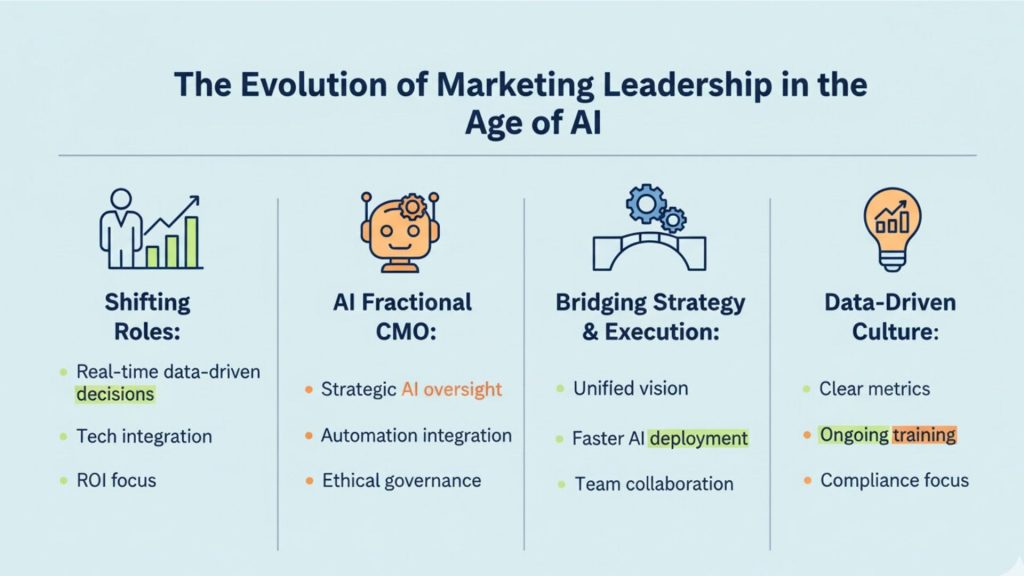
The Evolution of Marketing Leadership in the Age of AI
Shifting Roles of Marketing Leadership
Traditional CMOs were primarily responsible for creative direction, brand positioning, and campaign management. As marketing evolved, these skills remained essential but became insufficient for organizations that now rely heavily on data to drive decision-making. Modern leaders need to understand predictive analytics, machine learning, and how to align data insights with customer experience.
Key aspects of this shift include:
- Decision-making driven by real-time customer and market data rather than intuition
- Integration of technology platforms to ensure a seamless flow of insights across marketing channels
- A stronger emphasis on return on investment through measurable outcomes
The Emergence of the AI Fractional CMO
For many organizations, particularly those in growth phases or undergoing digital transformation, hiring a full-time AI-focused CMO is impractical. The AI fractional CMO model provides executive-level expertise on a part-time or project basis. This approach enables businesses to access strategic leadership without incurring the expense of a permanent executive hire.
An AI fractional CMO typically provides:
- Oversight of the AI marketing strategy and alignment with business objectives
- Integration of big data and marketing automation initiatives across departments
- Development of governance frameworks to ensure compliance and ethical use of AI-driven personalization
Bridging Strategy and Execution
The greatest obstacle for many businesses is not the availability of technology but the ability to translate advanced analytics into actionable marketing campaigns. An AI fractional CMO plays a central role in bridging strategy and execution by coordinating technical teams, data scientists, and creative marketers.
Benefits of this alignment include:
- A unified vision for both customer experience and operational efficiency
- Faster deployment of AI models into production environments
- Improved collaboration between data engineering and creative teams
Building a Culture of Data-Driven Decision-Making
A successful AI marketing plan requires more than technology. It demands a cultural shift where data-driven insights inform every decision. Organizations that cultivate this mindset achieve stronger consistency across channels and higher adaptability to market changes.
Essential elements of such a culture are:
- Clear communication of performance metrics to stakeholders
- Continuous training for marketing teams to use AI-driven insights effectively
Adoption of compliance standards for data privacy, such as GDPR and CCPA
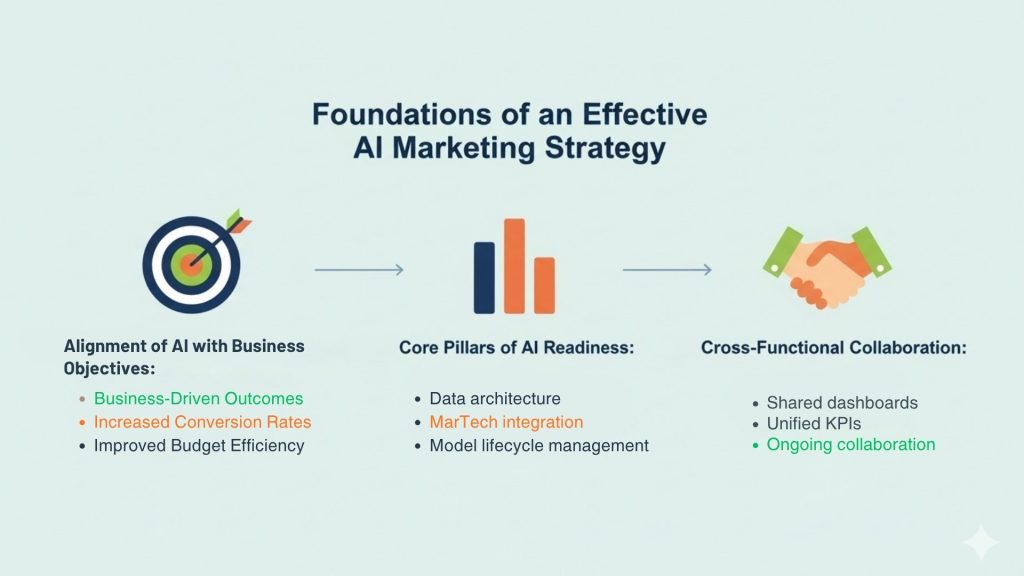
Foundations of an Effective AI Marketing Strategy
Aligning AI with Business Objectives
An AI marketing strategy begins by defining precise business outcomes before selecting tools or models. AI should not be treated as a novelty but as a mechanism to achieve measurable goals such as higher conversion rates, increased customer lifetime value, and improved budget allocation efficiency.
Key steps for alignment include:
- Conducting a full audit of existing marketing operations and data readiness
- Mapping AI use cases directly to revenue and customer growth goals
- Ensuring leadership buy-in to support investment in infrastructure and change management
Aligning these elements helps organizations avoid implementing AI solutions that fail to produce meaningful results. This foundation is essential for transforming pilot projects into scalable operations.
Building the Core Pillars of AI Readiness
A robust AI-driven marketing framework rests on three critical pillars: data architecture, MarTech integration, and model lifecycle management.
- Data architecture: Establishes centralized repositories such as data warehouses or customer data platforms to store and manage structured and unstructured information.
- MarTech integration: Connects platforms like CRM, advertising tools, and analytics dashboards to enable smooth data flow and unified insights.
- Model lifecycle management: Introduces processes to deploy, monitor, and optimize predictive models while maintaining transparency and compliance.
Organizations that prioritize these pillars build resilient systems capable of scaling with customer demand and evolving market conditions.
Encouraging Cross-Functional Collaboration
The complexity of AI marketing initiatives requires seamless cooperation between marketing strategists, technical teams, and data scientists. A well-structured collaboration model ensures that data-driven insights translate into actionable campaigns.
Recommended practices include:
- Establishing cross-functional task forces to review KPIs and adjust strategy as new insights emerge
- Creating shared dashboards for visibility into campaign performance and model accuracy
- Scheduling recurring sessions to evaluate automation workflows and brainstorm innovation opportunities
These collaborative structures ensure that insights generated by AI tools are implemented efficiently and aligned with strategic objectives.
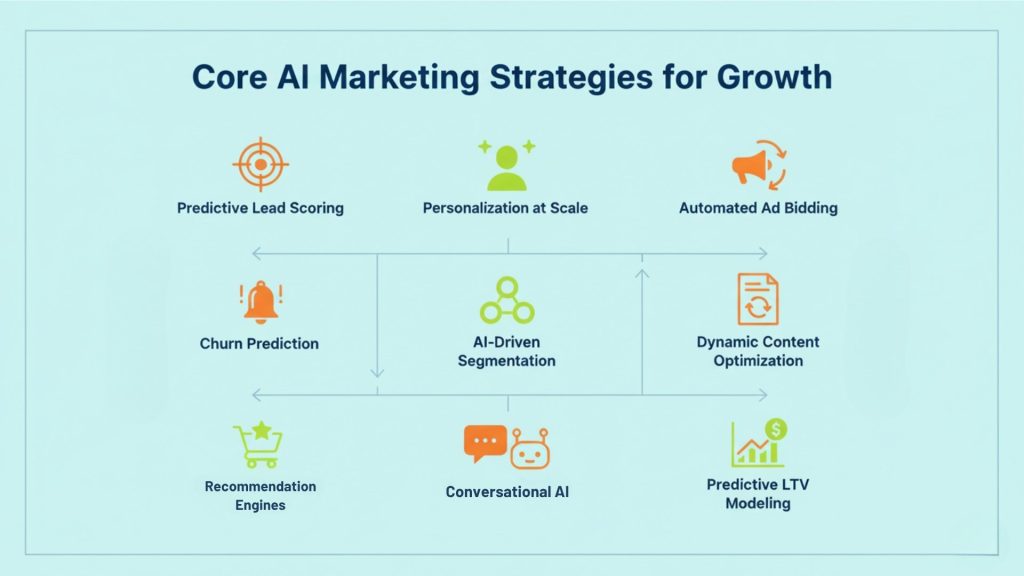
Core AI Marketing Strategies for Growth
A successful AI marketing strategy combines data-driven insights with automation to drive measurable results across the customer journey. While AI technologies provide the foundation, the real impact comes from applying them to specific, proven strategies that enhance acquisition, engagement, and retention.
1. Predictive Lead Scoring
AI algorithms analyze historical interactions, demographics, and behavioral signals to identify leads most likely to convert. Prioritizing high-potential leads improves sales efficiency and reduces acquisition costs.
2. Personalization at Scale
Machine learning models process customer data to deliver hyper-personalized messaging across channels, from email to on-site recommendations. Personalized experiences lead to higher engagement, conversion rates, and customer loyalty.
3. Automated Ad Bidding and Budget Allocation
AI-powered bidding platforms adjust ad spend in real time based on audience behavior, competitive dynamics, and predicted ROI. This approach maximizes return on ad spend and reduces wasted budget.
4. Real-Time Churn Prediction and Retention Triggers
Predictive analytics identifies customers at risk of churn by analyzing engagement patterns. Automated workflows can then deploy targeted offers or retention messages before customers disengage.
5. AI-Driven Customer Segmentation
Advanced clustering techniques segment audiences beyond basic demographics, grouping customers by behavioral patterns and purchase intent. These refined segments allow for highly tailored campaigns.
6. Dynamic Content Optimization
AI tools automatically adjust website headlines, email subject lines, or ad creatives to test and deliver the most effective version for each audience segment.
7. Recommendation Engines for Cross-Sell and Upsell
Recommendation algorithms suggest complementary products or services at the right moment, increasing average order value and enhancing customer experience.
8. Conversational AI and Virtual Assistants
AI chatbots and voice assistants manage customer inquiries, provide product guidance, and support purchase decisions around the clock, improving satisfaction and reducing support costs.
9. Predictive Lifetime Value Modeling
AI calculates the projected long-term value of individual customers or segments, enabling businesses to allocate marketing budgets toward the most profitable audiences.
These strategies collectively transform how companies attract, engage, and retain customers, turning data insights into revenue-generating actions.
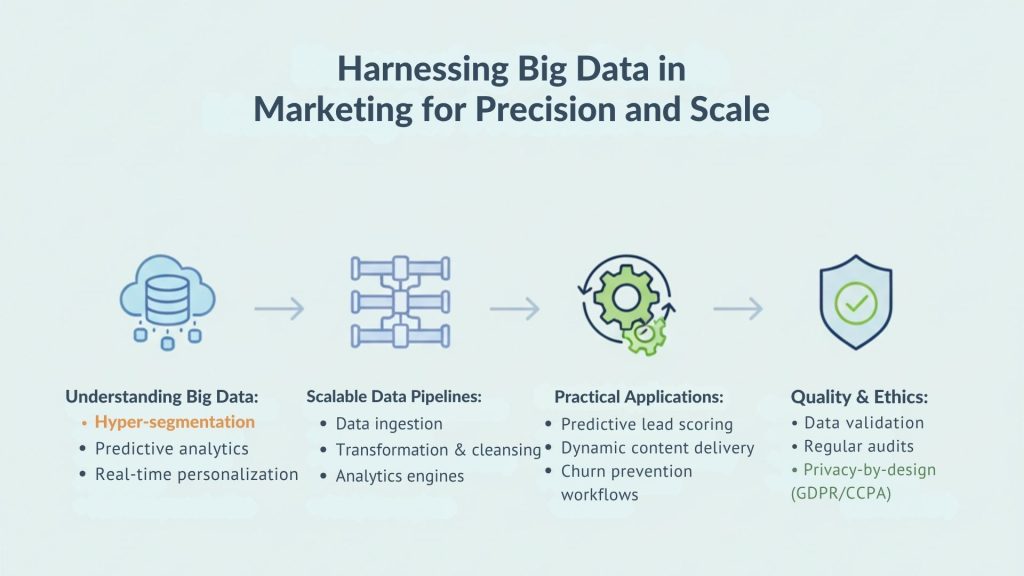
Harnessing Big Data in Marketing for Precision and Scale
Understanding the Role of Big Data in Marketing
Big data in marketing involves collecting and analyzing large-scale datasets generated by customer interactions, digital footprints, transactions, and other engagement signals. The advantage of big data lies in its capacity to deliver granular insights about customer behavior and preferences.
Strategic uses of big data include:
- Hyper-segmentation to target niche audiences more effectively
- Predictive analytics to anticipate purchasing behavior and reduce churn
- Real-time personalization of offers and content to improve engagement rates
Organizations that harness big data effectively gain a competitive edge by tailoring messages to individual needs and improving return on investment.
According to McKinsey & Company, organizations that invest in artificial intelligence technologies have achieved a 10–20 percent increase in sales ROI and a 3–15 percent uplift in revenue.
Building Scalable Data Pipelines
To operationalize big data insights, businesses must develop scalable data pipelines that integrate seamlessly with marketing automation platforms. Modern pipelines often rely on cloud infrastructure to handle high data volumes efficiently and in near real time.
Essential components of such pipelines include:
- Data ingestion layers capable of collecting first-party and third-party data from multiple sources
- Data transformation and cleansing processes to ensure accuracy and consistency
- Analytics engines that feed dashboards and machine learning models for decision-making
Well-designed pipelines enable organizations to shift from retrospective reporting to proactive optimization.
Practical Applications of Big Data and Marketing Automation
The integration of big data and marketing automation creates opportunities for personalized, data-driven campaigns at scale. Notable applications include:
- Predictive lead scoring to prioritize prospects most likely to convert
- Dynamic content delivery that tailors messaging based on browsing and purchase behavior
- Real-time bidding adjustments in advertising platforms to allocate budget toward high-performing segments
- Automated churn prevention workflows triggered by behavioral signals
These applications demonstrate how data-driven insights can directly improve both efficiency and customer experience.
Addressing Data Quality Considerations
Despite its benefits, leveraging big data presents challenges in quality management and ethical use. Poor-quality data can lead to misguided predictions and wasted resources, while insufficient attention to compliance can result in reputational and regulatory risks.
To mitigate these issues, organizations should:
- Establish stringent data validation and cleansing protocols
- Regularly audit data pipelines for consistency and completeness
- Implement privacy-by-design frameworks to meet regulations such as GDPR and CCPA
- Maintain transparency with customers regarding how their data is collected and used
Building trust through ethical practices ensures that big data initiatives deliver sustainable benefits and maintain customer confidence.
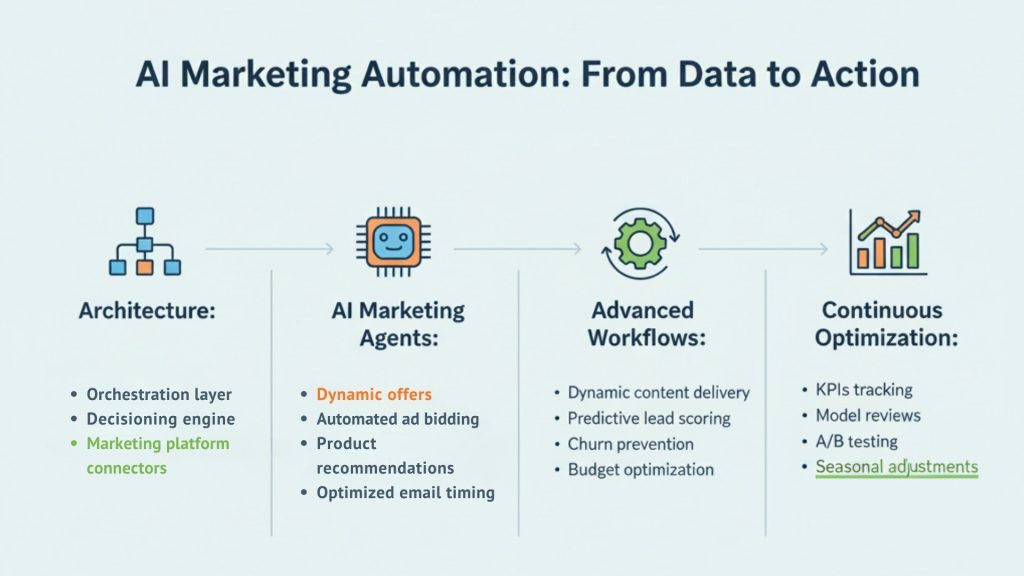
AI Marketing Automation: From Data to Action
Designing the Architecture of AI Marketing Automation
AI marketing automation enables businesses to transform static campaigns into adaptive experiences that respond dynamically to customer behavior. The architecture typically consists of:
- An orchestration layer that coordinates workflows across channels
- A decisioning engine that interprets predictive model outputs and determines the next best action
- Connectors to marketing platforms such as email, paid media, chatbots, and personalization engines
The effectiveness of this architecture depends not only on the sophistication of the algorithms but also on the efficiency of data integration. High-performing systems ensure that predictions and triggers reach marketing platforms in real time.
HubSpot highlights a concrete example of how AI can directly impact marketing outcomes. In one of their blog case studies, the company shared how they converted a traditional nurture email flow into an AI-driven process. By leveraging AI to analyze user intent and deliver one-to-one personalization at scale, HubSpot achieved an 82% increase in conversion rates for that specific email stream. This demonstrates how AI isn’t just about efficiency gains, it can fundamentally shift performance metrics when applied strategically.
Role of AI Marketing Agent Technologies
AI marketing agent technologies operate as autonomous systems that analyze customer signals, make recommendations, and execute actions across campaigns. These agents bridge the gap between predictive insights and immediate operational execution.
Common use cases for AI marketing agents include:
- Adjusting offers dynamically based on inventory levels and user engagement
- Automating ad bidding strategies in response to real-time audience performance
- Suggesting personalized product recommendations within websites or apps
- Optimizing email send times and subject lines based on behavioral data
These agents help marketing teams achieve personalization at scale without requiring constant manual intervention.
Advanced Workflows for Intelligent Automation
The combination of AI and automation allows organizations to design workflows that go beyond basic scheduling. Examples of advanced workflows include:
- Dynamic content delivery: Personalizing messaging on websites and in emails based on individual browsing patterns.
- Predictive lead scoring: Ranking and prioritizing prospects in the CRM system to focus resources on the most likely converters.
- Churn prevention campaigns: Triggering retention actions automatically when early warning signs of disengagement appear.
Budget optimization in advertising: Redirecting spend to channels and segments with better predicted performance.
These workflows enhance both the efficiency and the impact of marketing campaigns by ensuring that actions are timely, relevant, and data-driven.
Continuous Monitoring and Optimization
AI marketing automation requires ongoing measurement and refinement to remain effective. Best practices for continuous improvement include:
- Establishing KPIs for engagement, conversion, customer lifetime value, and campaign ROI
- Conducting regular model performance reviews to identify drift or declining accuracy
- Running A/B and multivariate tests to validate the impact of automated workflows
- Adjusting decisioning rules to account for seasonal patterns or changes in customer behavior
A mature automation strategy treats optimization as an iterative cycle, where insights from performance data inform the next phase of adjustments.
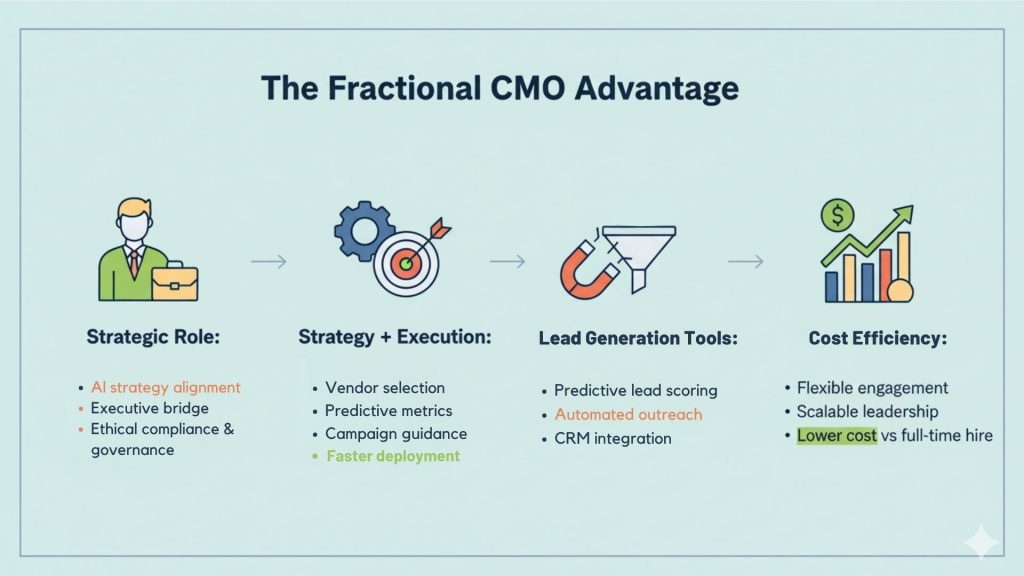
The Fractional CMO Advantage
The Strategic Role of an AI Fractional CMO
An AI fractional CMO offers organizations access to senior marketing leadership without the cost and commitment of a full-time executive. This model is especially valuable for businesses seeking to integrate big data and AI into their marketing operations while managing budget constraints.
A recent Salesforce survey revealed that 51% of marketers are already using generative AI (with another 22% planning to soon), highlighting the growing importance of leaders who can bridge strategy and AI execution, a key strength of a fractional CMO.
Key contributions of an AI fractional CMO include:
- Defining and guiding the AI marketing strategy in alignment with organizational goals
- Bridging gaps between executive leadership, marketing teams, and data science functions
- Overseeing compliance, ethical AI practices, and governance frameworks for AI-driven personalization
The flexibility of this model enables businesses to scale strategic oversight according to project demands and growth stages.
Combining Strategic Oversight with Operational Execution
An AI fractional CMO is most effective when balancing high-level strategic vision with hands-on involvement in execution. This approach ensures that technical initiatives remain aligned with overarching business goals.
Typical responsibilities may include:
- Evaluating and selecting vendors for data platforms, analytics tools, and automation solutions
- Defining success metrics for predictive models and ensuring consistent reporting
- Guiding creative teams to develop campaigns informed by predictive insights
- Coordinating marketing and technical teams for faster project deployment
This dual focus on strategy and execution accelerates the adoption of AI-driven initiatives and improves outcomes.
Leveraging AI Tools for Fractional CMO Lead Generation
One of the most direct ways an AI fractional CMO adds value is through enhanced lead generation. AI tools for fractional CMO lead generation typically combine predictive analytics with automated outreach systems to prioritize and engage high-potential prospects.
Key capabilities of these tools include:
- Identifying leads with the highest conversion probability based on historical data and behavior patterns
- Automating personalized messaging across email, social channels, and sales engagement platforms
- Integrating with CRM systems to keep sales teams focused on the most valuable opportunities
These tools help marketing and sales teams reduce acquisition costs while improving overall conversion performance.
Cost Efficiency and Scalability of Fractional Leadership
Fractional leadership offers a cost-effective solution for companies that need senior-level expertise but want to avoid the expense of a permanent hire. This approach is particularly beneficial during transitional phases such as product launches, market expansions, or digital transformations.
Advantages include:
- Access to experienced leadership without long-term financial commitment
- Flexibility to scale engagement levels according to project needs
- Exposure to diverse insights from fractional CMOs who have worked across various industries
Organizations gain the strategic direction necessary to implement AI marketing plans effectively while maintaining budgetary discipline.
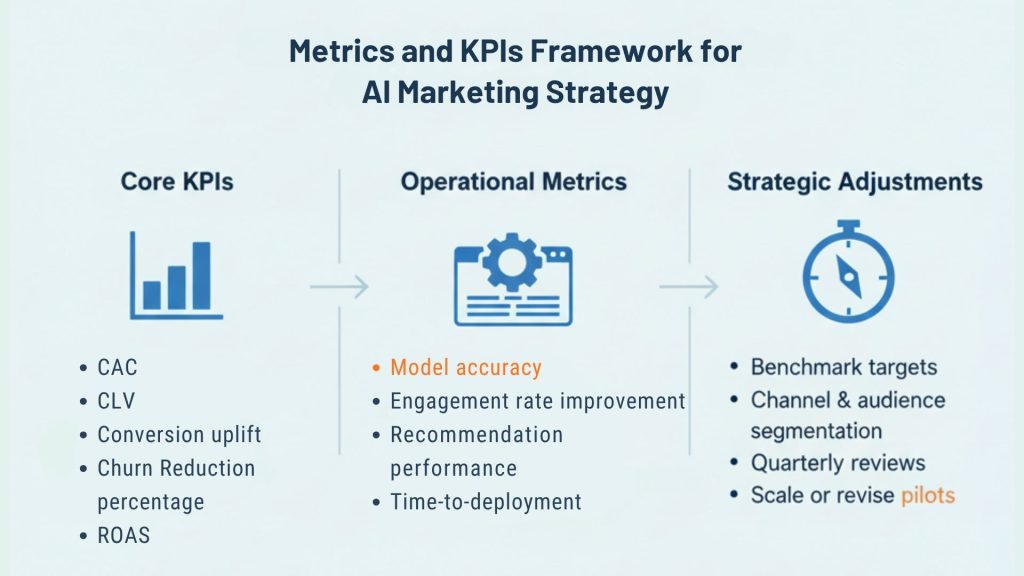
Metrics and KPIs Framework for AI Marketing Strategy
Tracking the right metrics is critical to understanding the effectiveness of AI-driven initiatives. A well-structured KPI framework enables leaders to quantify performance, optimize campaigns, and demonstrate the return on investment of AI marketing automation and big data in marketing.
Core KPIs for AI Marketing Success
The following key performance indicators provide a baseline for measuring how well an AI marketing strategy delivers results:
- Customer acquisition cost (CAC): Evaluates the efficiency of campaigns in acquiring new customers at scale.
- Customer lifetime value (CLV): Measures the long-term revenue potential of each customer segment influenced by predictive models.
- Conversion rate uplift: Tracks improvements in lead-to-customer or visitor-to-buyer conversions due to personalization and automation.
- Churn reduction percentage: Quantifies the impact of retention campaigns guided by predictive analytics.
- Return on ad spend (ROAS): Shows the incremental revenue generated per dollar spent across AI-optimized channels.
These KPIs help marketing teams focus on outcomes that tie directly to business growth.
Measuring AI-Driven Campaign Impact
Beyond core financial metrics, organizations should monitor the operational effectiveness of their AI initiatives. Operational KPIs provide insight into how well the underlying automation and predictive models perform.
Important operational metrics include:
- Model accuracy and precision: Reflects how reliably predictive algorithms forecast outcomes like churn or conversion.
- Engagement rate improvement: Highlights changes in user interaction across email, social, and on-site channels.
- Content recommendation performance: Evaluates click-through rates or purchases influenced by AI-driven recommendations.
- Time-to-deployment for campaigns: Assesses how efficiently the organization launches new data-driven workflows.
Tracking these indicators ensures continuous optimization of both strategy and infrastructure.
KPI Interpretation and Strategic Adjustments
Metrics alone are insufficient without structured interpretation and decision-making processes. Leadership teams, including fractional CMOs, must use KPI insights to guide resource allocation and campaign adjustments.
Recommended practices for interpreting KPIs include:
- Establishing benchmark targets for each metric to assess progress consistently
- Segmenting performance by channel, audience, and campaign to pinpoint opportunities for improvement
- Conducting quarterly reviews to align results with evolving business goals
- Using KPI data to decide which pilot programs to scale and which to revise or retire
A disciplined approach to KPI analysis ensures that investments in AI marketing plans deliver tangible benefits over time.
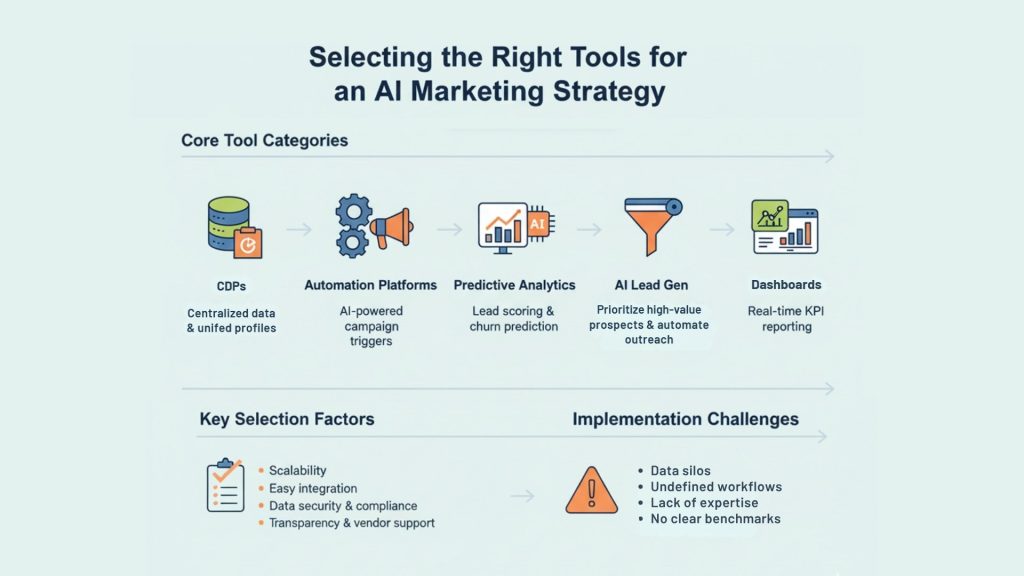
Selecting the Right Tools for an AI Marketing Strategy
Implementing a successful AI marketing strategy requires choosing technology platforms that can handle data complexity, automation needs, and seamless integrations. Selecting the right tools ensures that predictive models and automation workflows operate efficiently while minimizing technical bottlenecks.
Key Categories of Essential Tools
An effective AI-driven marketing stack typically includes a combination of the following categories:
- Customer data platforms (CDPs): Centralize first-party and third-party data, unify customer profiles, and feed information into personalization engines.
- Marketing automation platforms: Execute campaigns across email, SMS, push notifications, and paid channels with rule-based and AI-powered triggers.
- Predictive analytics tools: Provide insights for lead scoring, churn prediction, and personalized content recommendations.
- AI tools for fractional CMO lead generation: Identify high-value prospects, automate outreach, and prioritize sales-ready leads.
- Visualization and reporting dashboards: Present KPI trends in real time to guide strategic decisions and identify performance gaps.
These core components create an integrated ecosystem where data flows continuously across touchpoints.
Factors to Consider During Tool Selection
Not every tool suits every organization. Careful evaluation against technical and operational requirements ensures better alignment with business goals.
Important selection factors include:
- Scalability: Capacity to manage increasing volumes of customer and transactional data without sacrificing performance.
- Ease of integration: Compatibility with existing CRM systems, advertising platforms, and analytics dashboards.
- Data security and compliance: Built-in safeguards to meet GDPR, CCPA, and other regional privacy regulations.
- Transparency and explainability: Ability to understand how predictive models generate recommendations or scores.
- Support and training: Availability of onboarding resources and vendor support to shorten adoption timeframes.
A disciplined approach to tool selection reduces future rework and accelerates the time-to-value of AI marketing investments.
Common Implementation Challenges
Even with the right tools, organizations often face obstacles during implementation that can undermine success if left unaddressed.
Typical challenges include:
- Data silos that prevent full utilization of AI capabilities
- Poorly defined workflows that delay campaign execution
- Insufficient technical expertise leading to underuse of advanced features
- Lack of clear performance benchmarks for evaluating tool effectiveness
Mitigating these issues early through proper planning and stakeholder involvement is essential for realizing AI marketing benefits at scale.
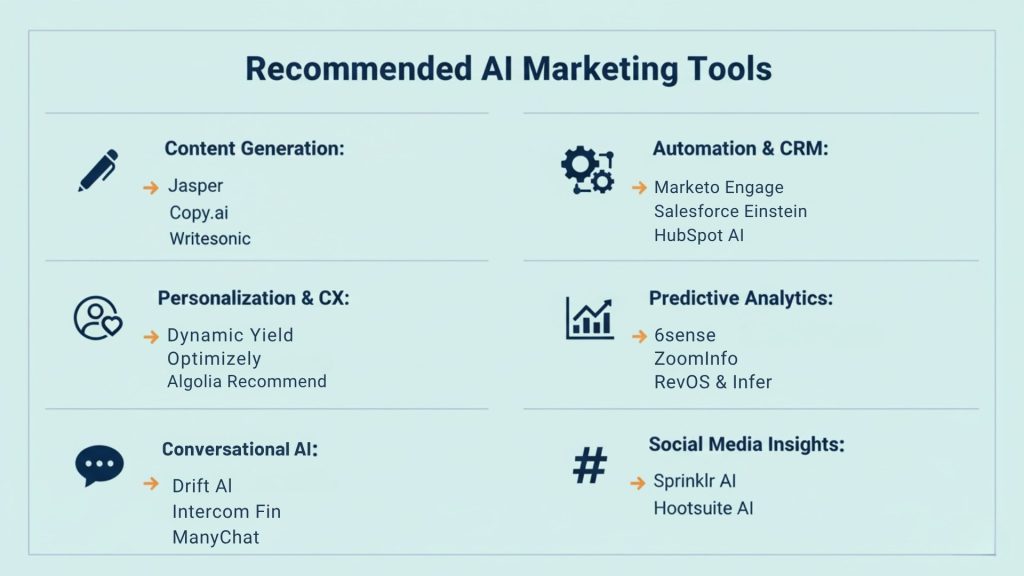
Recommended AI Marketing Tools
Selecting the right AI marketing tools is crucial for putting strategies into action. The following examples represent a cross-section of popular solutions that can enhance automation, personalization, and analytics in modern marketing operations. These tools serve as practical starting points for organizations looking to invest in technology that complements their AI marketing plan.
Content Generation and Creative Optimization
- Jasper: AI-powered platform for generating high-quality blog posts, ad copy, and email content quickly.
- Copy.ai: Streamlines creative writing for headlines, product descriptions, and social media captions.
- Writesonic: Supports long-form and short-form content creation optimized for marketing and SEO.
Marketing Automation and CRM Integration
- HubSpot AI: Offers built-in predictive lead scoring, email optimization, and customer journey automation.
- Marketo Engage (Adobe): Provides advanced segmentation, lead nurturing, and real-time personalization.
- Salesforce Einstein: Integrates AI-driven recommendations, lead prioritization, and analytics within Salesforce CRM.
Personalization and Customer Experience
- Dynamic Yield: Delivers personalized recommendations, adaptive content, and testing tools for web and mobile channels.
- Optimizely: Enables AI-driven experimentation and A/B testing to improve campaign performance.
- Algolia Recommend: Offers search-based personalization and product discovery for ecommerce experiences.
Predictive Analytics and Lead Intelligence
- 6sense: Uses intent data and predictive modeling to identify high-value accounts for B2B sales and marketing.
- ZoomInfo RevOS: Provides enriched lead data and AI insights to accelerate pipeline generation.
- Infer: Predicts conversion probability to prioritize leads and guide sales strategies.
Conversational AI and Customer Engagement
- Drift AI: Combines chatbots, automated meeting booking, and conversational analytics to capture and qualify leads.
- Intercom Fin: AI-powered support bot that enhances customer engagement and reduces response times.
- ManyChat: Automates messaging across Facebook Messenger, Instagram, and WhatsApp for lead nurturing and sales.
Social Media and Sentiment Analysis
- Sprinklr AI: Offers advanced sentiment analysis, social listening, and engagement tools for brand management.
- Hootsuite AI: Suggests optimal posting times, predicts engagement, and analyzes social performance across platforms.
These tools empower organizations to implement their AI marketing strategies with greater precision and efficiency. When combined with robust data pipelines and guided by an experienced fractional CMO, they enable seamless execution of campaigns across channels.
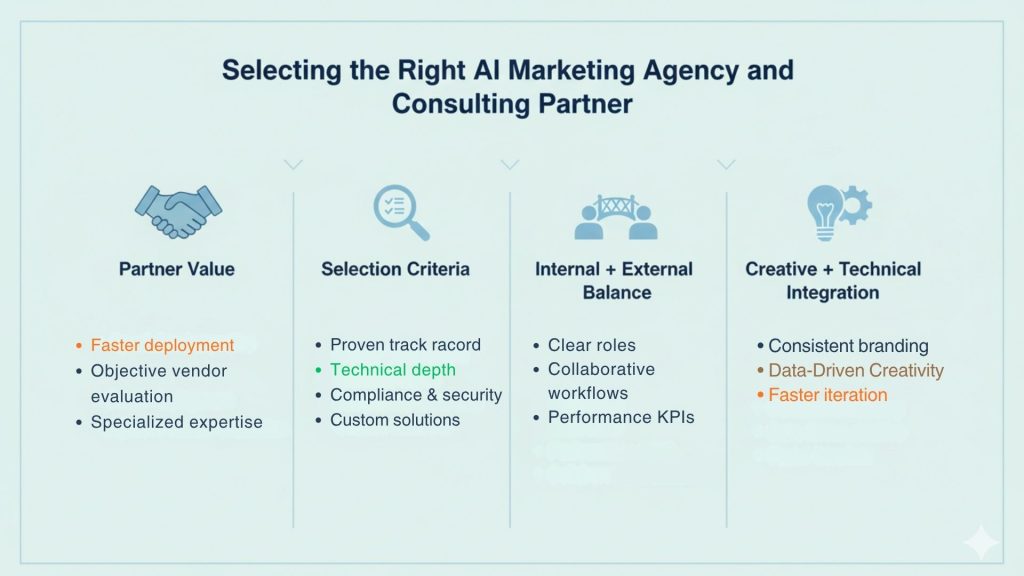
Selecting the Right AI Marketing Agency and Consulting Partner
Importance of the Right Partner Selection
The successful execution of an AI marketing strategy often depends on choosing the right partners. Many organizations lack the in-house expertise to design, implement, and scale AI-driven campaigns effectively. Collaborating with the right agency or consultant bridges this gap and ensures that investments in AI marketing automation and big data analytics yield measurable results.
Key benefits of working with external partners include:
- Access to specialized technical and strategic expertise that may not exist internally
- Faster project deployment due to pre-established workflows and best practices
- Objective evaluation of technology vendors and platforms
AI Marketing Agency Selection Criteria
Selecting an AI marketing agency requires a disciplined approach. Criteria that should be evaluated include:
- Proven track record: Case studies demonstrating success in delivering AI marketing benefits for similar industries.
- Technical depth: Capabilities in machine learning, big data processing, and marketing automation platform integration.
- Transparency: Clear explanation of models, methodologies, and expected outcomes.
- Compliance and security posture: Robust data governance practices that meet regulatory requirements.
- Customization capabilities: Ability to tailor AI solutions to unique business needs rather than offering one-size-fits-all services.
These criteria help organizations identify agencies capable of driving both strategic and operational excellence.
Balancing Agency Support with Internal Leadership
While agencies and consultants play an essential role, internal leadership remains crucial. An AI fractional CMO can oversee the relationship with external partners, ensuring alignment with broader business objectives and maintaining control over strategic direction.
Recommended best practices include:
- Defining roles and responsibilities clearly between the internal team and the external agency
- Setting performance-based KPIs to evaluate the agency’s contributions regularly
- Establishing collaborative workflows for sharing data, insights, and campaign performance metrics
- Conducting periodic reviews to ensure the agency’s solutions continue to meet evolving organizational needs
Integrating Creative Services with Technical Expertise
AI-driven campaigns often require both technical execution and creative storytelling. Agencies that combine these strengths offer a distinct advantage by seamlessly blending advanced analytics with compelling content strategies.
Organizations benefit from:
- Consistent branding across automated and human-created touchpoints
- Faster iteration on creative assets informed by real-time performance data
- Stronger collaboration between creative directors, data scientists, and marketing leaders
This integration helps maximize the impact of AI marketing plans by ensuring that campaigns resonate with audiences while remaining data-informed.
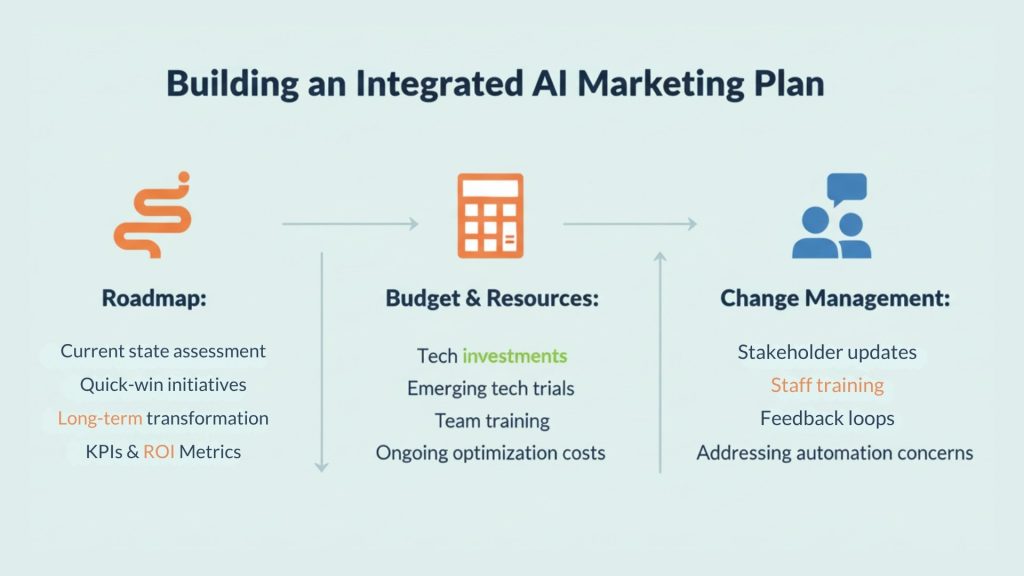
Building an Integrated AI Marketing Plan
Establishing a Roadmap for Implementation
An AI marketing plan should begin with a detailed roadmap that prioritizes initiatives according to business impact and organizational readiness. This roadmap must outline short-term wins alongside long-term transformation goals.
Key components of an effective roadmap include:
- Current state assessment: Evaluate existing data maturity, MarTech capabilities, and operational processes.
- Quick-win initiatives: Identify projects that can deliver immediate AI marketing benefits, such as automated lead scoring or personalized email campaigns.
- Long-term transformation projects: Plan for advanced initiatives like predictive modeling for customer lifetime value or multimodal content generation.
- Defined KPIs and ROI metrics: Establish clear performance indicators to measure success across all phases.
This structured approach allows organizations to focus on measurable progress rather than attempting large-scale changes all at once.
Budgeting and Resource Allocation
Implementing AI-driven marketing requires investments in both technology and talent. Proper budgeting ensures that financial resources are aligned with priorities and that leadership understands the projected return on investment.
Effective budgeting strategies include:
- Allocating funds for cloud infrastructure, data management, and automation tools
- Reserving a portion of the budget for experimentation with emerging technologies
- Setting aside resources for training internal teams and hiring external expertise where needed
- Incorporating ongoing maintenance and model optimization costs to avoid budget shortfalls later
By planning budgets strategically, organizations can deploy their AI marketing plan in phases that minimize disruption and maximize returns.
Change Management and Stakeholder Alignment
The introduction of AI-driven processes often requires cultural and operational changes across departments. Clear communication and proactive change management are essential to avoid resistance and ensure smooth adoption.
Best practices for stakeholder alignment include:
- Providing regular updates to executives and teams on progress and benefits achieved
- Offering training sessions to help staff understand how to interpret AI insights and leverage them in daily work
- Creating feedback loops where users of AI-driven systems can share insights and identify areas for improvement
- Recognizing and addressing concerns about the impact of automation on roles and responsibilities
An integrated approach that combines technological readiness with cultural buy-in leads to greater long-term success.
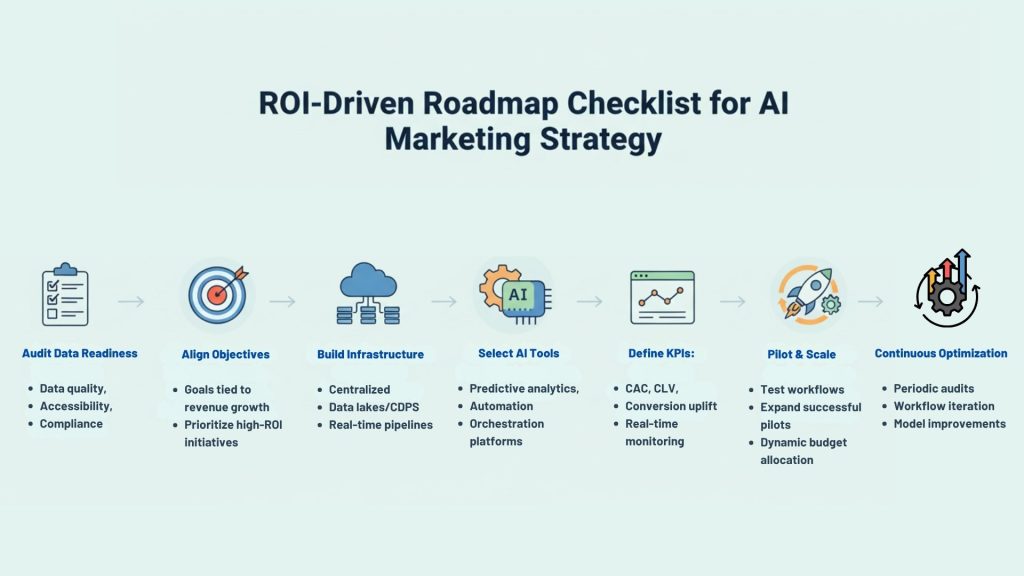
ROI-Driven Roadmap Checklist for AI Marketing Strategy
A well-planned roadmap guides organizations from initial exploration of AI-powered marketing to scalable execution that delivers measurable returns. By following a structured sequence, businesses reduce risk, control costs, and achieve tangible improvements in customer acquisition and retention.
Step-by-Step Roadmap
The following checklist outlines the critical steps for implementing an ROI-focused AI marketing plan:
- Audit data readiness:
- Identify available first-party and third-party data sources.
- Assess data quality, accessibility, and compliance with privacy regulations.
- Align objectives with business outcomes:
- Define clear goals such as increasing conversion rates or reducing churn.
- Prioritize initiatives that tie directly to revenue growth or cost efficiency.
- Build or refine data infrastructure:
- Establish centralized data lakes or CDPs for unified customer views.
- Ensure pipelines support real-time ingestion and transformation.
- Select and integrate AI and automation tools:
- Choose platforms for predictive analytics, orchestration, and personalization.
- Integrate tools with CRM, advertising, and reporting systems.
- Establish KPIs and measurement protocols:
- Set benchmarks for CAC, CLV, conversion uplift, and churn reduction.
- Implement dashboards to monitor campaign performance in real time.
- Launch pilot programs:
- Start with limited-scope projects to validate model performance and operational workflows.
- Adjust workflows based on pilot insights before scaling.
- Scale successful initiatives:
- Expand high-performing pilots to additional channels or customer segments.
- Allocate budgets dynamically to maximize ROI.
- Continuously optimize:
- Conduct periodic model audits to detect performance drift.
- Iterate on workflows, creative assets, and predictive models based on new data.
Benefits of an ROI-Focused Approach
Following a roadmap that emphasizes measurable outcomes delivers key advantages:
- Faster validation of AI initiatives before committing large budgets
- Improved collaboration between marketing, technical, and executive teams
- Reduced risk of failed implementations by prioritizing high-impact use cases
- Greater stakeholder confidence in the financial results of AI marketing investments
A checklist-driven roadmap ensures every phase of AI adoption contributes directly to business growth and long-term sustainability.
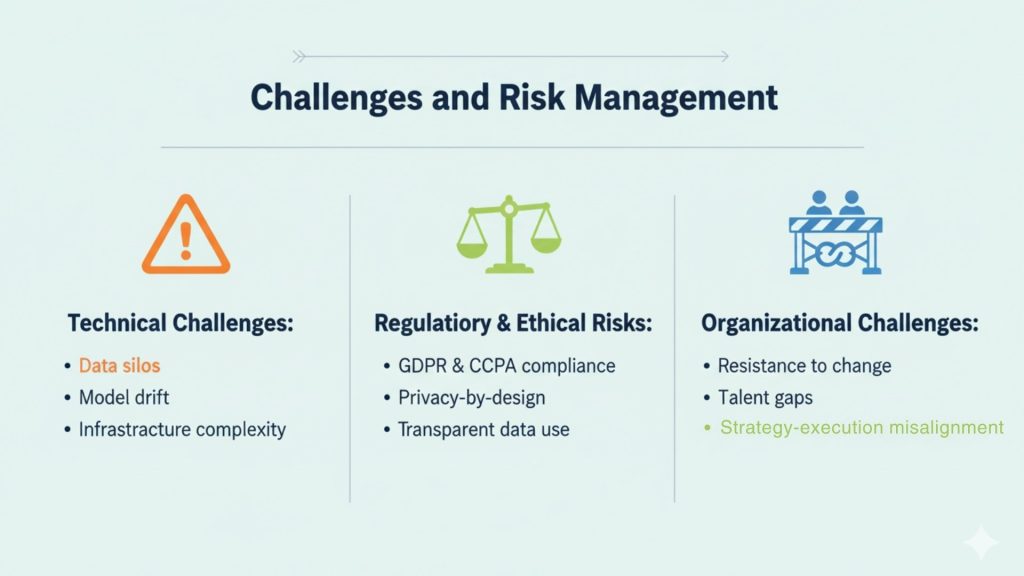
Challenges and Risk Management
Technical Challenges
Adopting AI in marketing brings several technical challenges that must be addressed early to ensure sustainable success:
- Data silos: Fragmented data across departments limits the effectiveness of machine learning models.
- Model drift: Predictive models can lose accuracy over time as customer behavior evolves.
- Infrastructure complexity: Scaling data pipelines and automation platforms requires robust cloud architecture and ongoing monitoring.
Mitigating these challenges involves investing in scalable systems, maintaining active data governance processes, and implementing regular model validation protocols.
Regulatory Risks
AI-driven personalization often involves the collection and analysis of sensitive customer data. Organizations must comply with privacy regulations to maintain trust and avoid penalties.
Key areas of focus include:
- Ensuring compliance with GDPR, CCPA, and other regional data privacy laws
- Applying privacy-by-design principles to data collection and model development
- Maintaining transparency about how customer data is used to generate insights
- Establishing processes for explaining AI-driven decisions to customers when necessary
Proactively addressing these risks protects brand reputation and reduces exposure to regulatory penalties.
According to Cisco’s 2024 Data Privacy Benchmark Report, 76% of consumers remain concerned about how their personal data is used for AI-driven personalization. IDC forecasts that by 2026, 70% of global organizations will adopt privacy-preserving machine learning to balance personalization with compliance.
Organizational Challenges
Even with strong technology and compliance measures, human and organizational factors can create obstacles:
- Resistance from teams accustomed to traditional marketing methods
- Difficulty in recruiting or retaining staff with the right mix of marketing and data science skills
- Misalignment between leadership’s strategic vision and operational capabilities
Solutions include building a strong culture of continuous learning, encouraging collaboration across functions, and involving leadership in the ongoing refinement of AI strategies.
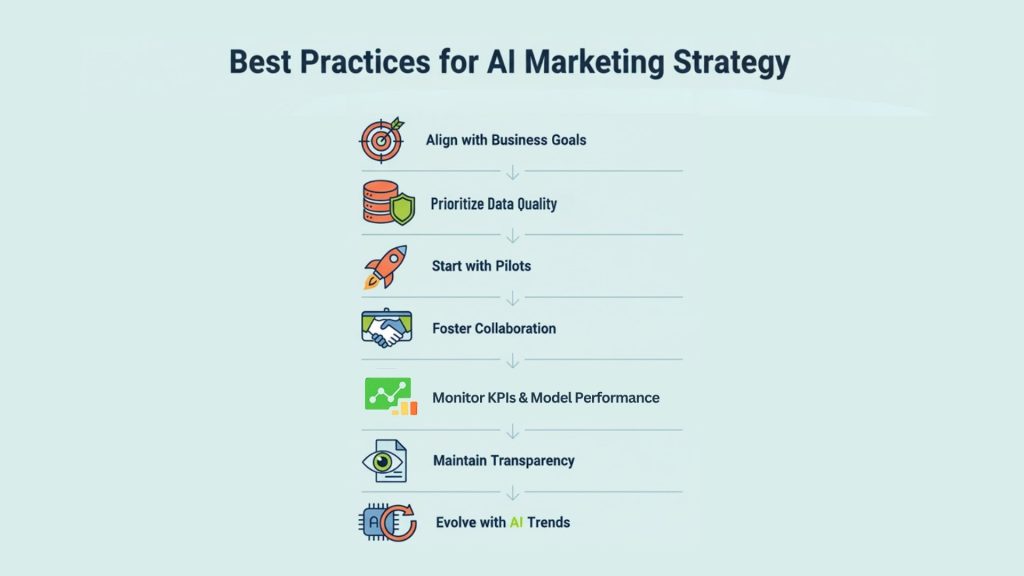
Best Practices for AI Marketing Strategy
Implementing an AI marketing strategy requires a deliberate approach that balances innovation with governance. Following established best practices helps organizations avoid common pitfalls, maximize ROI, and maintain customer trust while scaling AI-driven campaigns.
1. Align AI Initiatives with Business Goals
Ensure every AI-driven project supports measurable outcomes such as improving customer acquisition, boosting retention, or lowering campaign costs. Clear alignment prevents wasted investments in technology that does not deliver business value.
2. Prioritize Data Quality and Governance
High-quality, well-governed data is the foundation of any AI system. Invest in cleaning, unifying, and securing data across channels to improve model accuracy and comply with regulations like GDPR and CCPA.
3. Start with Pilot Projects Before Scaling
Begin with targeted pilot programs to validate models and workflows on a smaller scale. Scaling proven pilots minimizes risks, reveals operational gaps, and provides early evidence of ROI to stakeholders.
4. Foster Collaboration Across Departments
Bring together marketing, data science, IT, and compliance teams to ensure smooth integration of AI solutions. Cross-functional collaboration accelerates adoption and reduces friction during deployment.
5. Monitor KPIs and Model Performance Continuously
Track critical metrics such as conversion uplift, churn reduction, and ROI alongside operational indicators like model accuracy and response times. Regular reviews help detect drift or underperformance early.
6. Maintain Transparency with Customers
Communicate clearly about personalization practices and data usage to build and preserve customer trust. Transparent policies reduce regulatory risks and enhance brand credibility.
7. Keep Evolving with Emerging AI Trends
AI technologies change rapidly, and staying competitive requires adapting strategies to leverage advancements in generative AI, multimodal models, and privacy-preserving techniques as they emerge.
Adopting these best practices helps organizations build resilient AI marketing plans that drive sustainable growth while maintaining compliance and consumer confidence.
Accenture’s research indicates that 91% of consumers are more likely to shop with brands that recognize, remember, and provide them with relevant offers and recommendations.
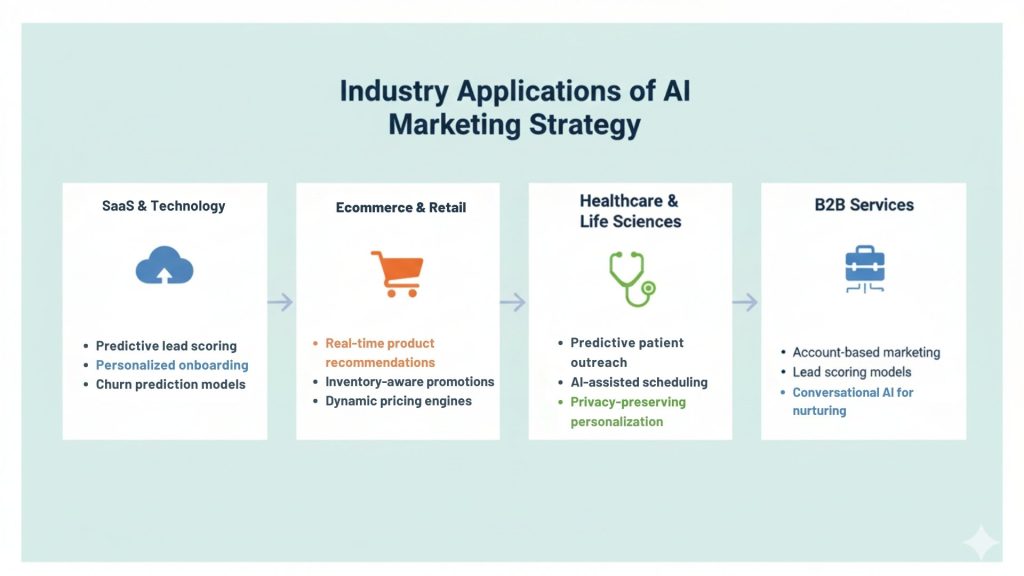
Industry Applications of AI Marketing Strategy
AI-driven marketing strategies create significant opportunities across industries by adapting to the unique data environments, customer expectations, and compliance requirements of each sector. Highlighting these applications helps organizations visualize tangible use cases and better align investments with their industry’s demands.
SaaS and Technology
SaaS and technology companies often compete on rapid product innovation and customer retention. AI marketing strategy supports these priorities through:
- Predictive lead scoring to focus sales efforts on accounts with the highest likelihood of conversion
- Personalized onboarding workflows that adapt to user behavior within the software platform
- Customer churn prediction models that trigger proactive engagement or retention offers
These applications help SaaS providers shorten sales cycles and improve lifetime value for subscription-based customers.
Ecommerce and Retail
Ecommerce and retail businesses generate massive volumes of behavioral and transactional data that fuel AI-powered personalization. Key use cases include:
- Real-time product recommendations based on browsing history and purchase patterns
- Automated inventory-aware promotions that adjust offers by location and stock levels
- Dynamic pricing engines that respond to demand fluctuations, seasonal trends, and competitor activity
The ability to customize experiences at scale drives higher conversion rates and increases average order value.
Healthcare and Life Sciences
Healthcare organizations face strict privacy regulations and diverse patient needs. AI marketing strategy in this sector focuses on compliant, data-driven engagement:
- Predictive analytics to identify patients most likely to benefit from specific outreach programs
- AI-assisted appointment scheduling and follow-up reminders to improve patient adherence
- Privacy-preserving personalization to deliver relevant health content while safeguarding sensitive information
These solutions enhance patient engagement while maintaining compliance with healthcare privacy laws such as HIPAA.
B2B Services
B2B companies often contend with complex buying journeys and long sales cycles. AI marketing strategy streamlines these processes by:
- Account-based marketing campaigns that target high-value decision-makers with tailored content
- Scoring models that prioritize leads based on firmographic and behavioral signals
- Intelligent chatbots and conversational AI that nurture prospects and capture key insights
Such approaches enable B2B marketers to align resources with the most profitable opportunities and improve sales efficiency.
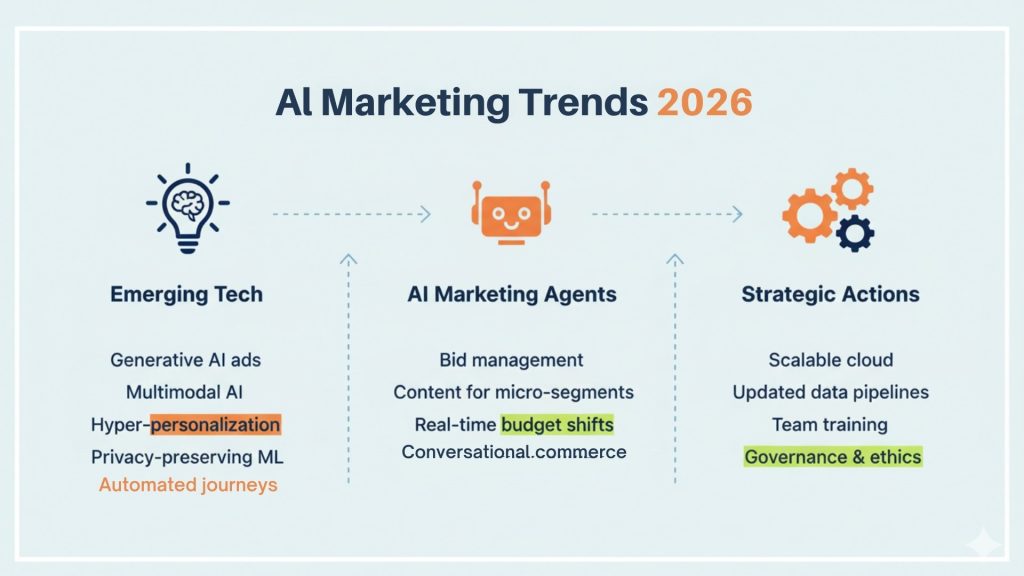
AI Marketing Trends 2026
Emerging Technologies Reshaping Marketing
AI marketing trends 2026 showcase a new wave of AI marketing ideas that are transforming how brands deliver personalization, creativity, and data-driven decision-making. These innovative approaches highlight the most impactful trends shaping the future of AI-powered marketing:
- Generative AI for creative optimization: Producing high-performing ad copy, video, and imagery tailored to audience preferences.
- Multimodal AI models: Combining text, voice, image, and video data to create richer customer interactions across channels.
- Hyper-personalized experiences: Using granular behavioral insights to deliver individualized journeys at scale.
- Privacy-preserving machine learning: Applying techniques such as federated learning to maintain personalization while respecting customer privacy.
- Automated customer journey orchestration: Seamlessly guiding users through awareness, consideration, and purchase phases with minimal manual intervention.
Organizations that adopt these technologies gain the agility to anticipate consumer needs and deliver more relevant experiences.
The Growth of AI Marketing Agents
AI marketing agents will continue to expand in functionality, serving as autonomous tools that manage campaigns and respond to data in real time. In 2026, these agents are expected to play a larger role in:
- Managing bids in advertising platforms without human intervention
- Recommending or even creating content for micro-segments within large audiences
- Monitoring campaign performance continuously and reallocating budgets accordingly
- Enabling conversational commerce by integrating with chatbots and virtual assistants
These advancements reduce operational workload for marketing teams while improving responsiveness and effectiveness.
Strategic Implications for Organizations
To remain competitive, businesses must adapt their AI marketing strategy to incorporate these innovations. Key actions include:
- Updating data pipelines and infrastructure to support multimodal and generative AI workloads
- Training teams to interpret and trust AI-driven recommendations in strategic decision-making
- Strengthening governance frameworks to address ethical and compliance issues related to AI-driven personalization
- Investing in scalable cloud platforms capable of real-time data ingestion and model deployment
Organizations that act early on these trends position themselves to lead in delivering enhanced customer experiences and achieving higher ROI.
Final Thoughts
Organizations that successfully combine big data in marketing, AI marketing automation, and fractional CMO leadership are better positioned to compete in increasingly data-driven markets. A well-executed AI marketing strategy transforms the customer experience by enabling precise personalization, predictive campaign optimization, and efficient resource allocation.
Key takeaways for leaders considering this journey include:
- Building a strong technical foundation for data collection, integration, and model deployment
- Aligning AI initiatives closely with business objectives to ensure measurable impact
- Fostering a culture of data-driven decision-making across all levels of the organization
- Leveraging the expertise of an AI fractional CMO or external consultants to accelerate transformation
- Choosing AI marketing agency partners based on clear selection criteria to ensure strategic alignment and technical excellence
By acting on these principles, organizations can unlock AI marketing benefits that lead to sustainable growth, greater customer loyalty, and competitive differentiation. Partnering with a creative and strategic agency can further enhance these efforts by integrating advanced AI solutions with innovative storytelling and branding strategies.

FAQ: AI Marketing Strategy and Fractional CMO Leadership
1. What are the most significant AI marketing benefits for businesses?
Key benefits include hyper-personalized customer experiences, predictive lead scoring, automated campaign optimization, and real-time budget reallocation. These capabilities increase conversion rates, reduce acquisition costs, and improve customer lifetime value.
2. How does an AI fractional CMO differ from a full-time CMO?
An AI fractional CMO provides executive-level marketing leadership on a part-time or project basis. This approach delivers strategic guidance, technical oversight, and hands-on execution for AI-driven initiatives without the cost of a full-time hire.
3. How do big data and marketing automation work together?
Big data in marketing supplies detailed customer insights from vast data sources, while marketing automation uses those insights to trigger targeted campaigns. The combination allows real-time personalization and predictive outreach at scale.
4. What KPIs should companies track to measure AI marketing success?
Organizations should focus on KPIs such as customer acquisition cost (CAC), customer lifetime value (CLV), conversion rate uplift, churn reduction, return on ad spend (ROAS), and engagement rate improvement. Monitoring these metrics ensures campaigns drive measurable ROI.
5. What challenges often arise when implementing AI marketing automation?
Common challenges include fragmented data silos, model drift affecting predictive accuracy, lack of team alignment across departments, and compliance issues related to privacy regulations. Addressing these early through planning and governance improves adoption success.
6. How can organizations start building an AI marketing plan?
Begin with a data readiness assessment, align objectives with revenue-driven outcomes, and prioritize initiatives with measurable ROI potential. Pilot small-scale projects first, refine workflows based on insights, and then scale high-performing campaigns.
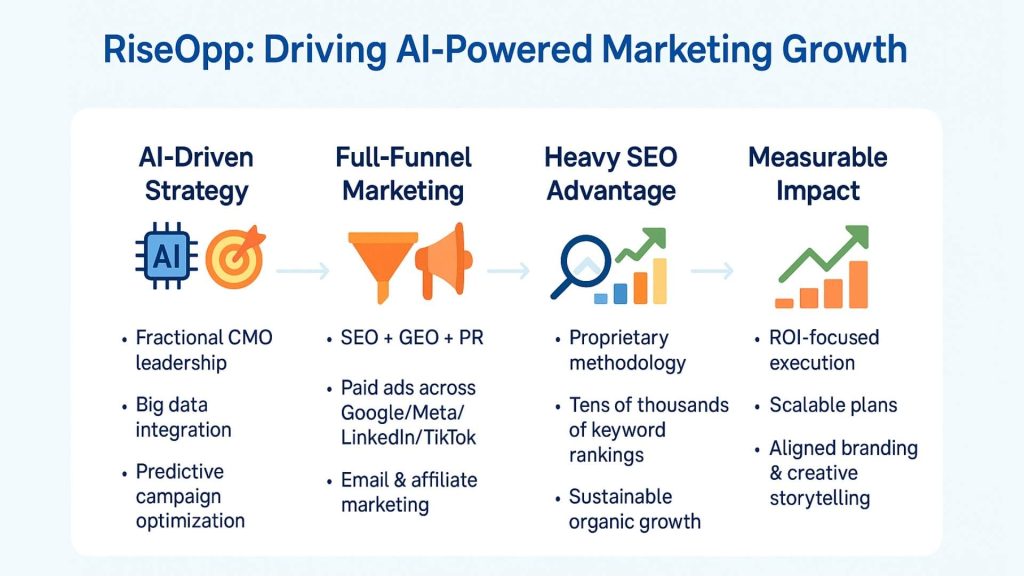
About RiseOpp: Your Partner in AI-Driven Marketing Leadership
At RiseOpp, we specialize in helping companies harness the power of big data and artificial intelligence to achieve meaningful business results. As a leading Fractional CMO and SEO services company, we have worked with organizations across industries to design and execute marketing strategies that thrive in the modern data-driven landscape.
Our Fractional CMO services extend well beyond strategy creation. We partner with B2B and B2C companies to shape branding and messaging, build marketing teams, and execute campaigns across channels that matter most for growth, including SEO, GEO, PR, Google Ads, Meta Ads, LinkedIn Ads, TikTok Ads, email marketing, and affiliate marketing. We understand that integrating an AI marketing strategy with these channels requires both technical expertise and creative insight, which is why our approach prioritizes measurable results.
When it comes to search visibility, our proprietary Heavy SEO methodology empowers businesses to rank for tens of thousands of keywords over time, providing a sustainable edge in competitive markets. This capability complements our Fractional CMO work by aligning organic growth with paid and AI-powered initiatives.
If your organization is exploring ways to combine big data in marketing, AI marketing automation, and executive-level leadership to achieve measurable growth, we invite you to connect with us. Our team at RiseOpp is ready to guide you through building an AI marketing plan that delivers tangible ROI and long-term success.
Comments are closed